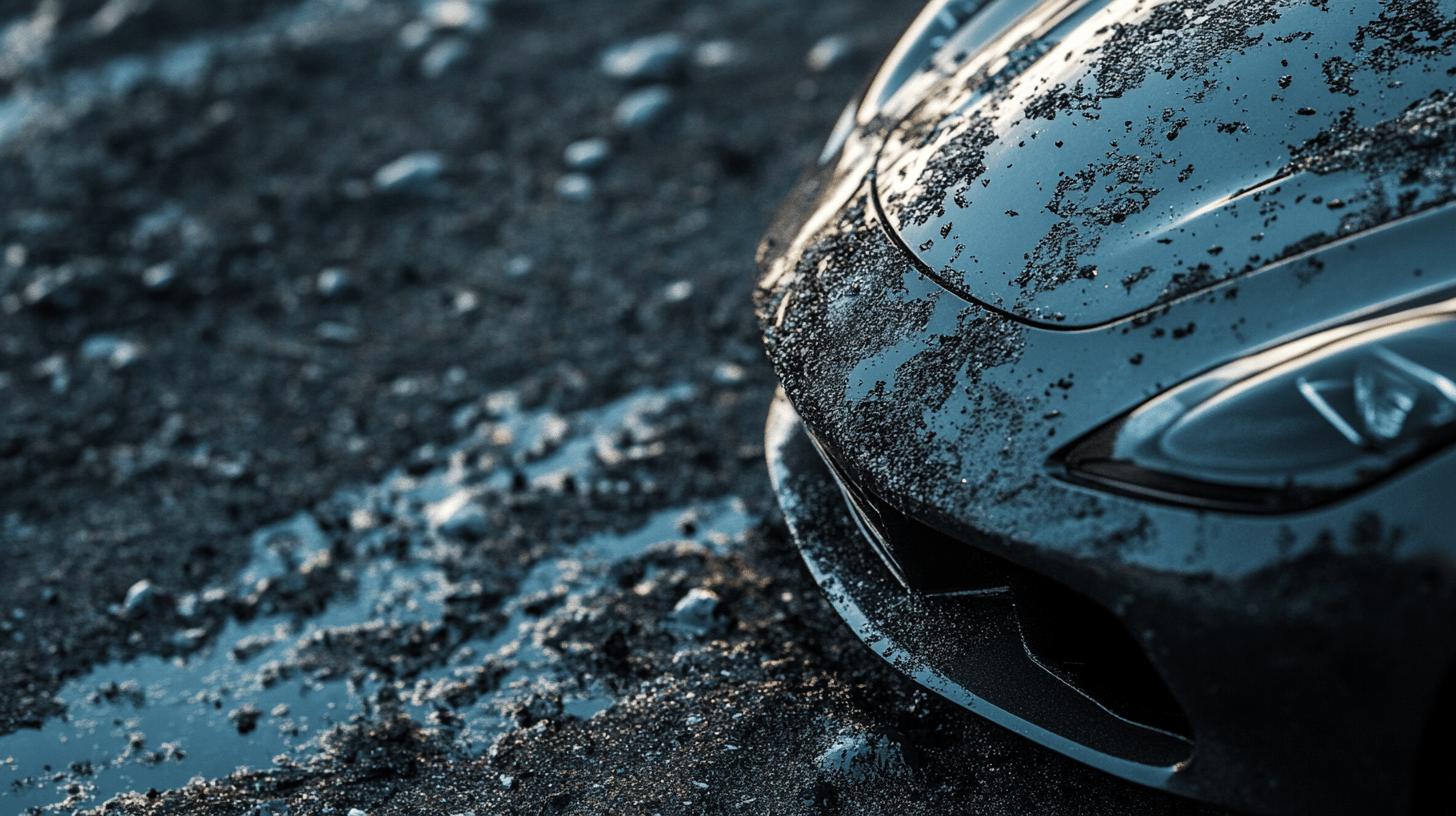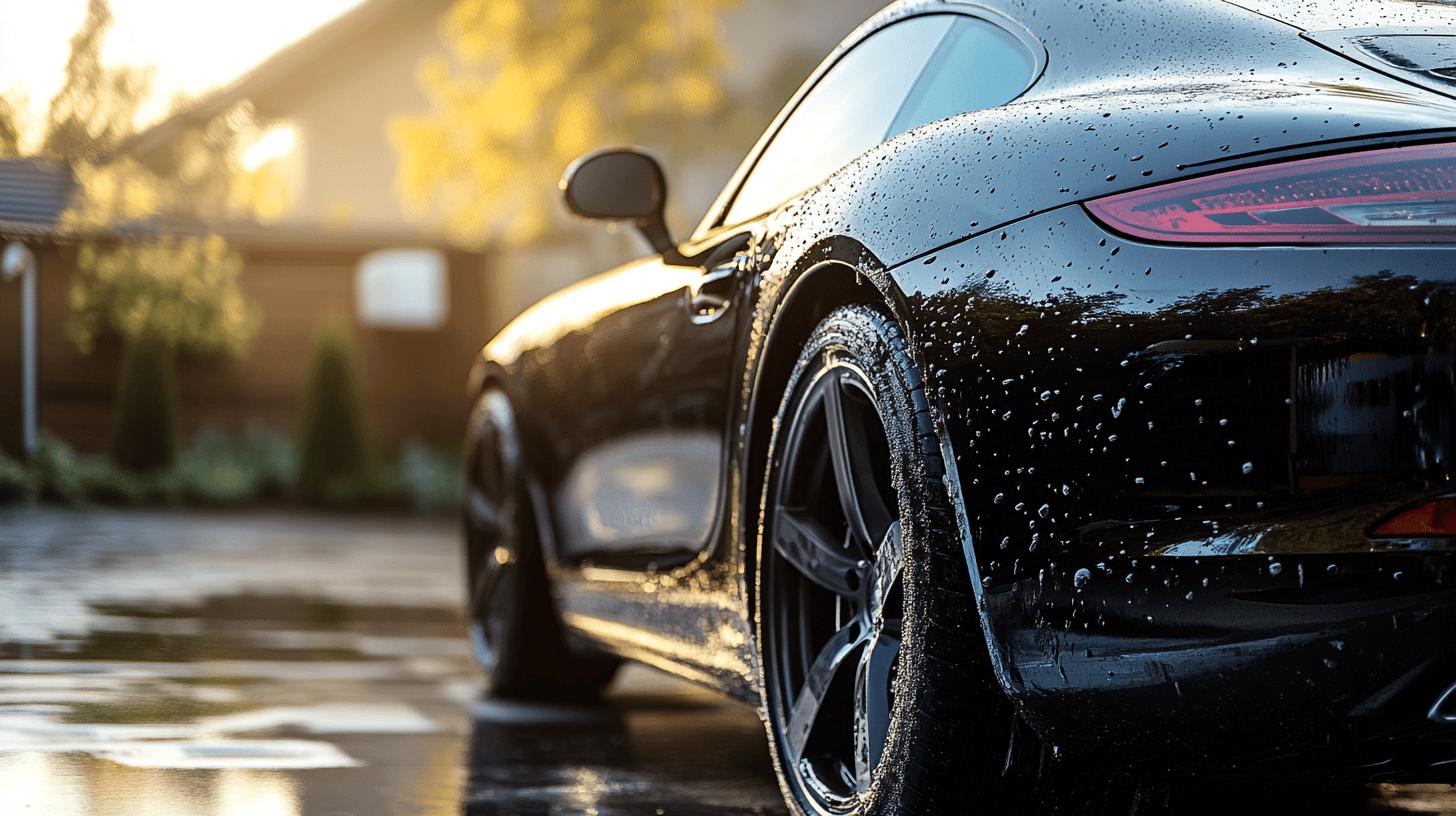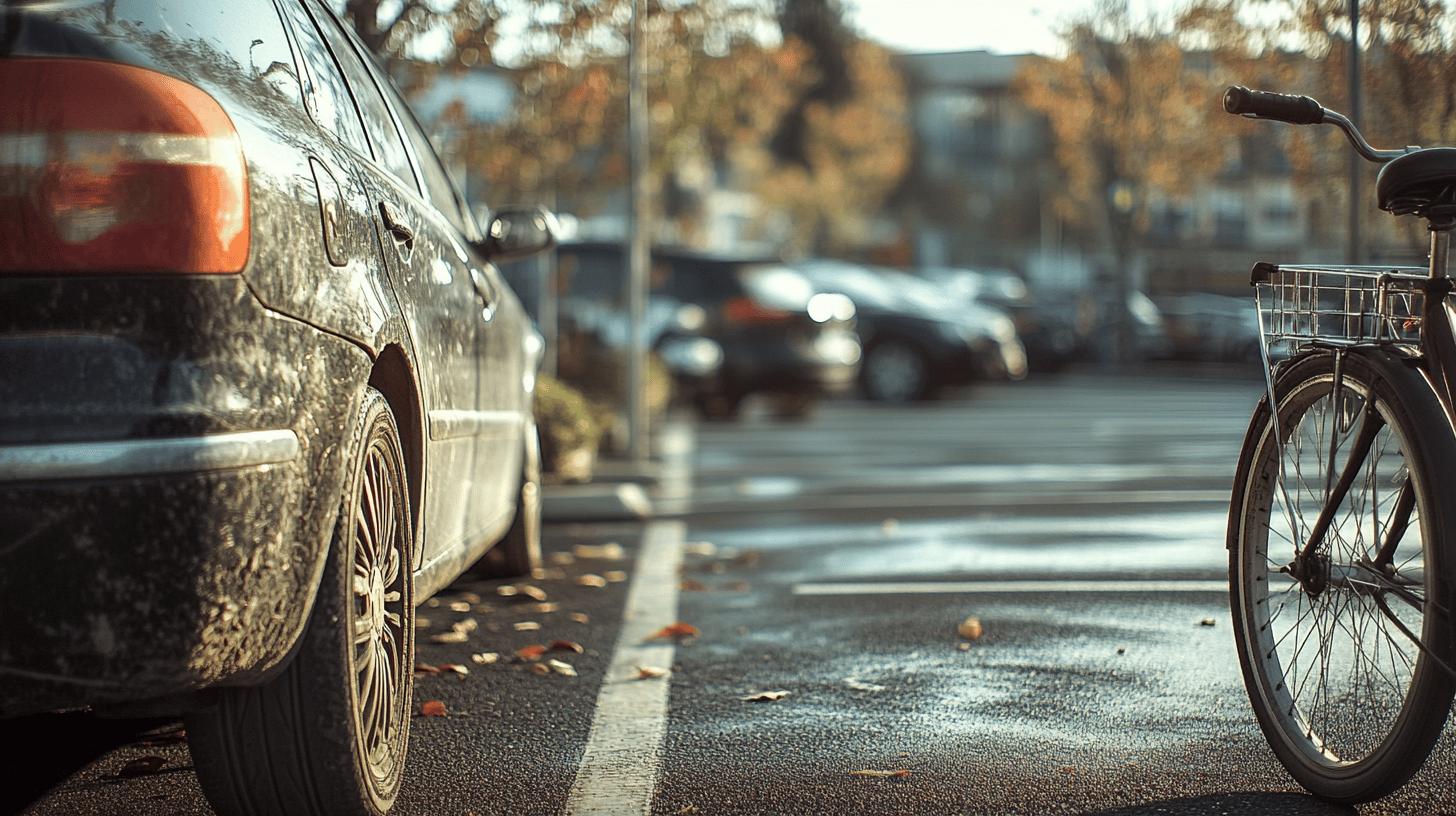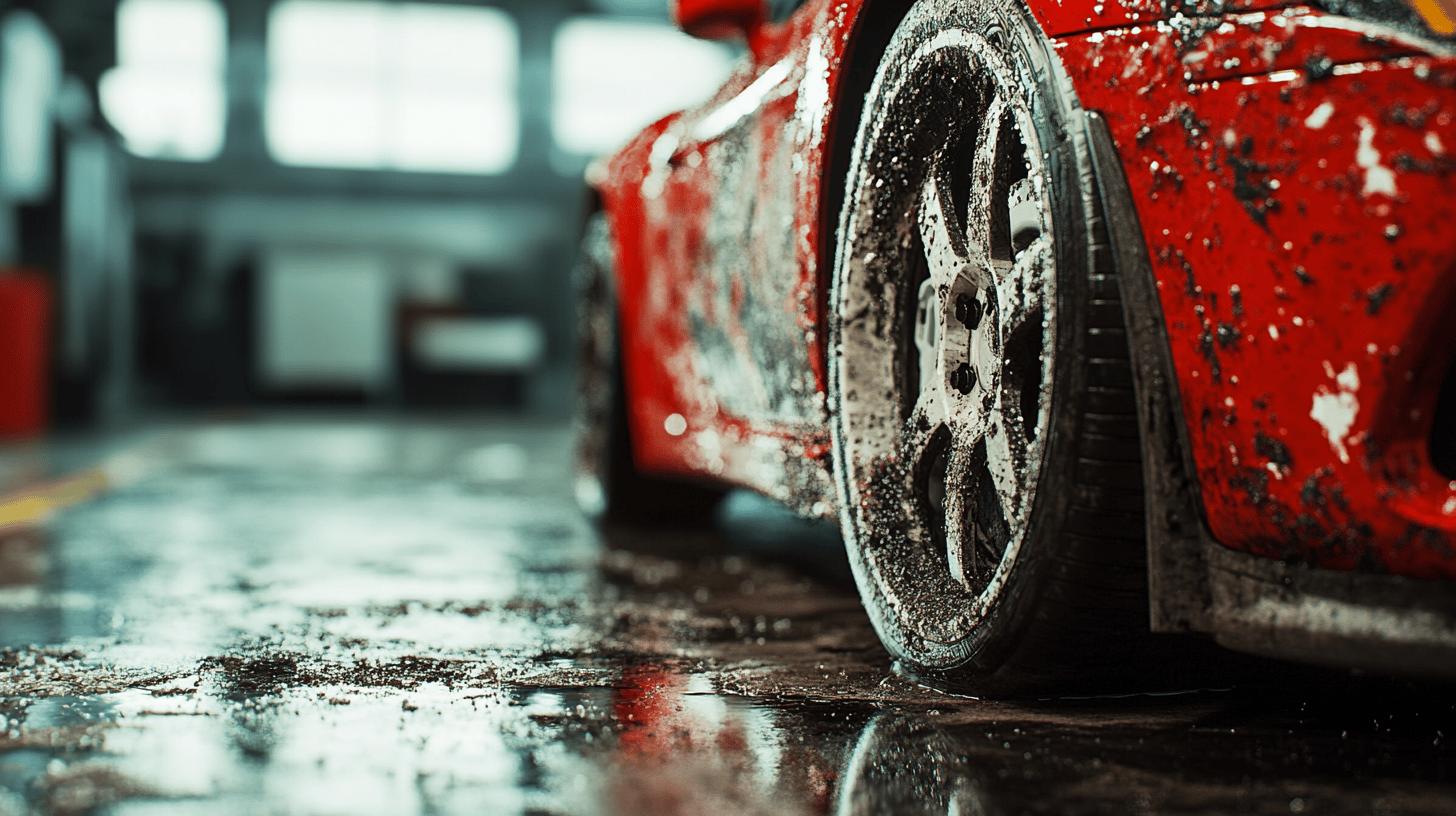Ever wondered just how easily your car’s pristine paintwork can be ruined? From harsh weather conditions to reckless use of shopping trolleys, the culprits are more common than you think. Understanding the causes behind those unsightly scratches and paint damage is crucial for maintaining your vehicle’s appearance and value. In this article, Velocity Car Spray explores the 10 most frequent offenders behind car scratches and paintwork damage, offering actionable insights and preventive measures to keep your ride looking its best. Dive in to learn how to protect your car from these all-too-common threats.
Weather-Related Paintwork Damage
Winter weather poses significant threats to car paintwork, primarily due to road salt, sleet, and snow. Road salt, used for de-icing, is highly corrosive and can create paintwork abrasions, especially if not washed off promptly. Snow and sleet contain moisture that can seep into minor paint cracks, leading to rust formation. The combination of grit and salt on winter roads can also cause micro-scratches as it gets kicked up by driving, further harming the paint.
Summer weather and prolonged sun exposure can be equally damaging. The intense UV rays from the sun can cause paint to fade and oxidise, leading to a dull and lacklustre appearance. Paintwork can dry out and become more susceptible to chips and cracks, especially if the car is frequently exposed to direct sunlight. Coastal regions pose an added risk due to salt-laden rain, which can create stubborn water spots and further accelerate paint deterioration.
General maintenance tips are crucial to protect car paint from weather-related damage. Regular cleaning and waxing create a protective barrier against harsh elements. Applying a UV protectant can help combat sun damage, while frequent washing during winter months can remove corrosive salts and grit. Using a high-quality car cover or parking the vehicle in a garage can significantly reduce exposure to damaging weather conditions.
- Regularly wash your car to remove road salt and grit.
- Apply a UV protectant to shield the paint from sun damage.
- Use a high-quality car cover when parking outdoors.
- Wax your car periodically to create a protective barrier.
- Avoid parking under trees to prevent sap and bird droppings.
Routine inspections and prompt attention to minor scratches can prevent more extensive paint damage. Ensuring your car is adequately protected from harsh weather conditions will not only maintain its appearance but also its value over time.
Bird Droppings and Bug Splatter
Bird droppings are highly acidic and can cause permanent damage to car paint if not addressed promptly. The acidity can eat through the clear coat and into the paint, leading to discolouration and etching that may require professional repair. Careful removal with appropriate products is necessary to avoid further damage. Using a high-quality cleaner that dissolves the droppings without needing to scrub the paintwork is essential to prevent additional scratches. Immediate action is crucial to mitigate the corrosive effects of bird droppings on paintwork.
Removing dead bugs presents its own set of challenges due to their acidic nature and tendency to harden on the car’s surface. If not cleaned off quickly, dead bugs can become incredibly difficult to remove and can damage the paint. Carrying microfiber cloths for immediate cleaning is recommended. Microfiber is gentle on the paint and effective at removing bug residue without scratching the surface. Using a specialised cleaner designed to dissolve bug splatter can also make the task easier and protect the paint from further harm.
- Use a high-quality cleaner to dissolve bird droppings and bug splatter.
- Carry microfiber cloths for immediate cleaning of bird droppings and bugs.
- Avoid scrubbing the paintwork to prevent additional scratches.
- Clean affected areas as soon as possible to minimise damage.
Proper cleaning and preventive measures can significantly reduce the risk of permanent paint damage caused by bird droppings and bug splatter. By addressing these issues promptly and using the correct products and techniques, car owners can maintain their vehicle’s appearance and prolong the lifespan of its paintwork.
Road Debris and Stone Chips

Loose stones and pebbles, particularly on motorways, are a common cause of car paintwork damage. These small, hard objects are often kicked up by the tyres of other vehicles, striking your car with significant force. The bonnet and bumpers are typically the most affected areas, suffering from deep dings and chips. This kind of damage not only mars the appearance of your vehicle but can also expose the underlying metal, making it more susceptible to rust and further deterioration.
Road debris kicked up by other vehicles can also lead to circular dents and scratches on bumpers, bonnets, and side panels. This debris can include anything from small metal fragments to larger items like pieces of rubber or plastic. The impact of such debris can cause both superficial and extensive damage, depending on the size and speed of the object. Maintaining a safe distance from other cars, especially lorries and trucks, can help minimise the risk of road debris hitting your vehicle.
For those skilled at DIY repairs, stone chips are relatively easy to fix. You can purchase touch-up paint kits that match your car’s colour, allowing you to cover up small chips and prevent rust from setting in. However, for more extensive damage, it may be worth seeking professional help. DIY repairs require a steady hand and careful attention to detail to ensure a seamless finish. Incorrectly applied touch-up paint can look unsightly and may not provide adequate protection against the elements.
- Maintain a safe distance from other vehicles to reduce the risk of road debris impact.
- Use a clear protective film on vulnerable areas like the bonnet and bumpers.
- Regularly inspect your car for chips and scratches, addressing them promptly.
- Consider using a professional service for extensive paintwork damage.
Taking these preventive measures can help protect your car from the damaging effects of road debris and loose stones. Regular inspections and prompt repairs will ensure your vehicle remains in top condition, both aesthetically and structurally.
Parking-Related Scratches and Dents
Minor accidents in car parks are a common cause of car scratches and dents. These incidents often occur due to misjudged surroundings or tight parking spaces. Other drivers may unintentionally cause minor scratches and dents by opening their doors too wide or misaligning their vehicles. The crowded nature of many car parks increases the likelihood of such minor accidents, leading to unsightly and potentially costly damage to your vehicle’s paintwork.
Choosing the right parking location is crucial in minimising the risk of parking-related damage. Parking in less crowded areas can reduce the chances of another driver accidentally damaging your vehicle. Using protective measures such as dashcams with parking mode can offer additional protection. These devices can record any incidents, providing valuable evidence in case of disputes. Additionally, parking away from high-traffic areas can further reduce the risk of scratches and dents.
Bumper scrapes against curbs are another common issue caused by poor spatial awareness. Many drivers misjudge the distance between their car and the curb, especially where there is a camber in the road. This can lead to significant paintwork damage on the lower part of the bumper. Being mindful of curbs and taking extra care when parking can help avoid such scrapes. Utilising parking sensors or cameras can also assist in better judging distances and angles, thereby protecting your vehicle’s paintwork.
- Park in less crowded areas to minimise the risk of accidental damage.
- Use dashcams with parking mode for added protection and evidence collection.
- Avoid high-traffic areas within car parks.
- Utilise parking sensors or cameras to judge distances accurately.
- Be mindful of curbs, especially where there is a camber in the road.
By following these tips and being cautious about where and how you park, you can significantly reduce the risk of parking-related scratches and dents.
Protect your car’s paintwork – Contact us for expert advice and repair services today!
Vandalism and Intentional Damage
Vandalism can take many forms, including key scratches, graffiti, and other intentional damage to car paintwork. Key scratches are particularly notorious as they can be deep and extensive, often requiring professional repainting to fully repair. Graffiti, typically applied with spray paint or markers, can mar the appearance of your vehicle and may also be difficult to remove. Such acts of vandalism not only degrade the aesthetic value of your car but can also reduce its overall market value. The malicious intent behind these actions often leaves car owners with hefty repair bills and a sense of frustration.
Preventive measures can significantly reduce the risk of vandalism. Keeping your car in a secure location, such as a locked garage or a monitored parking area, can deter potential vandals. Utilizing car covers can also help, as they act as a physical barrier and make it harder for vandals to access the paintwork. Additionally, dashcams equipped with motion sensors and parking mode can provide crucial evidence in case of vandalism. These devices can capture footage of the incident, aiding in the identification of the culprits and supporting insurance claims. The mere presence of a dashcam can act as a deterrent, discouraging potential vandals from targeting your vehicle.
- Park your car in a secure, well-lit location to deter vandals.
- Use a car cover to protect the paintwork from intentional damage.
- Install a dashcam with motion sensors and parking mode for added security.
Poor Washing Techniques

Using abrasive cleaners and harsh scrapers can severely damage car paintwork. These products and tools are too harsh for the delicate surface of car paint and can create micro-scratches that degrade the paint’s appearance over time. Abrasive cleaners often contain rough particles designed to remove tough stains, but these particles can also strip away the protective clear coat, exposing the paint to further damage. Similarly, harsh scrapers can leave deep scratches that may require professional repair to fix. Opting for gentler cleaning alternatives is crucial to maintaining the integrity of your vehicle’s paintwork.
Employing the right techniques and products is essential for effective and safe car washing. A soft brush or microfiber cloth should be used for cleaning, as these materials are designed to be gentle on paint surfaces. Microfiber cloths, in particular, are excellent for trapping dirt and debris without scratching the paint. When drying the car, a patting motion is recommended to avoid dragging any remaining particles across the surface, which can cause scratches. Additionally, improper washing and shampooing can lead to permanent damage. Using a pH-balanced car shampoo can help preserve the paint’s protective layer, ensuring your vehicle stays in top condition.
- Use a microfiber cloth or soft brush for cleaning to prevent scratches.
- Employ a patting motion when drying to avoid dragging particles across the paint.
- Choose a pH-balanced car shampoo to maintain the paint’s protective layer.
- Avoid abrasive cleaners and harsh scrapers to protect the paintwork.
By following these proper car washing techniques, car owners can effectively safeguard their vehicle’s paintwork from damage, ensuring it remains pristine and well-protected over time.
Automatic Car Washes
Automatic car washes often use abrasive brushes that can cause significant damage to car paintwork. These brushes, designed to remove dirt and grime quickly, can also create swirl marks and scratches on the surface. The bristles, which may be embedded with grit and debris from previous washes, act like sandpaper against the paint. This not only mars the appearance of the vehicle but can also lead to more severe paint damage over time. Frequent use of such car washes can degrade the clear coat, exposing the underlying paint to further risks.
Safer alternatives to automatic car washes include non-touch car washes and professional detailing services. Non-touch car washes use high-pressure water jets and specialised cleaning solutions to remove dirt without physical contact, minimising the risk of scratches. Professional detailers employ meticulous hand-washing techniques using soft, high-quality materials and pH-balanced products to ensure the paintwork remains pristine. These methods provide a more thorough and gentle cleaning, preserving the vehicle’s finish and extending the longevity of its paintwork.
- Opt for non-touch car washes that use high-pressure water jets.
- Hire professional detailers for meticulous hand-washing services.
- Use at-home washing techniques with soft, high-quality materials.
Tree Branches and Hedges
Branches and twigs from hedges can gradually scratch your car’s paintwork, particularly if you frequently drive or park in rural areas. Over time, the repeated contact with these natural elements can lead to noticeable abrasions and scuffs on the surface of your vehicle. These scratches can penetrate the clear coat and affect the paint layer, potentially leading to more severe damage like rust if left unattended. Regularly buffing the car can help mitigate some of this damage, but prevention is always better than cure.
To avoid the damage caused by tree branches and hedges, there are several preventive measures you can take. Firstly, keeping your car away from overhanging branches and dense hedges is crucial. Parking in open spaces or garages can significantly reduce the risk of such scratches. Secondly, consider trimming any overhanging branches near your home or driveway to prevent accidental contact with your vehicle. Finally, installing protective car covers when parking outdoors can provide an extra layer of defence against natural elements. By following these steps, you can maintain the integrity of your car’s paintwork and avoid costly repairs.
- Park in open spaces or garages to avoid contact with branches and hedges.
- Trim overhanging branches near your home or driveway.
- Use protective car covers when parking outdoors.
Shopping Trolley and Bike Scratches

Shopping trolleys and bikes are common culprits behind car scratches and paintwork damage. Bike handlebars, footballs, and other activities involving children can lead to minor scratches on the car’s surface. These scratches, though often superficial, can accumulate over time and degrade the vehicle’s appearance. Shopping trolleys, on the other hand, can cause more significant scratches and dents, especially when they are carelessly pushed or left unattended in parking lots. The impact from a trolley can leave deep grooves in the paint, sometimes even requiring professional repair to restore the car’s finish.
Preventive measures can help avoid such damage. One effective strategy is to park your car away from trolley bays and high-traffic areas in car parks. This reduces the likelihood of a stray trolley making contact with your vehicle. Additionally, keeping your car concealed from children, either by parking in a garage or using a car cover, can prevent accidental scratches from bikes and other play activities. Regularly inspecting your car for minor scratches and addressing them promptly can also prevent more extensive paintwork damage over time.
- Park away from trolley bays and high-traffic areas in car parks.
- Keep your car concealed from children to prevent accidental scratches.
- Regularly inspect and address minor scratches to avoid extensive damage.
DIY Repairs and Professional Solutions
DIY repairs can be a practical option for addressing minor paint damage, such as stone chips and small scratches. If you are skilled at DIY repairs, you can purchase touch-up paint kits that match your car’s colour. These kits allow you to cover up small chips and scratches, preventing rust from setting in and protecting the underlying metal. However, DIY repairs require a steady hand and attention to detail to ensure a seamless finish. Incorrectly applied touch-up paint can look unsightly and may not provide adequate protection against the elements. Therefore, DIY repairs are best suited for minor damage that does not penetrate deeply into the paint layers.
For more significant damage, professional repainting or detailing services are recommended. Professional car body repair services have the tools, expertise, and materials to restore your vehicle to its original condition. They can handle extensive paintwork damage, including deep scratches, dents, and large areas of chipped paint. Professional services ensure that the repairs are done correctly and will blend seamlessly with the rest of the car’s paintwork. This not only maintains the aesthetic appeal of your vehicle but also helps preserve its market value. Velocitycarspray.co.uk, for example, offers high-quality car body repairs and repainting services that meet manufacturer standards.
- Touch-up paint kits for minor scratches and stone chips.
- Professional repainting for extensive paintwork damage.
- Detailing services to restore the car’s original appearance.
- Protective films are used to prevent future scratches and chips.
Final Words
In exploring the 10 Common Causes of Car Scratches and Paintwork Damage, we’ve highlighted key triggers such as harsh weather, bird droppings, road debris, and poor washing techniques.
Preventive measures are crucial to maintain your vehicle’s appearance and integrity.
Mindful parking, appropriate cleaning methods, and securing your car against vandalism can make a significant difference.
Ultimately, regular maintenance and adopting proper precautions will keep your car looking pristine and ensure its longevity.
Knowledge empowers vehicle owners to maintain their car’s value and aesthetic for years to come.
Protect your car’s paintwork – Contact us for expert advice and repair services today!
FAQ
Types of Car Scratches with Pictures
Scratches on cars can vary widely in depth and severity. Paint transfers, clear coat scratches, primer scratches, and deep paint scratches are common types. Understanding each helps in choosing the right repair method.
What Causes Scratches on Cars?
Scratches can be caused by a variety of factors including road debris, tree branches, bird droppings, bug splatters, poor washing techniques, and vandalism. Identifying the cause helps in preventing future damage.
Mysterious Scratches on Car Hood
Mysterious scratches can occur from falling debris, abrasive cleaning tools, or careless actions by others. Examining the area for rough spots may provide clues about the scratch’s origin.
Should I Feel Depressed Over a Scratch I Caused?
It’s natural to feel upset about causing a scratch on your car. However, most scratches can be repaired, either through DIY methods or professional services. Focus on restoring your car.
How to Remove Deep Scratches from Car
Deep scratches often require sanding, filling with touch-up paint, and buffing to achieve a smooth finish. Professional services may be necessary if the damage is extensive.
Vertical Scratches on Car
Vertical scratches are typically caused by objects scraping against the car’s sides, such as tree branches or objects in a garage. Identifying and removing these causes can prevent further damage.
Are Scratches on Cars Normal?
Yes, scratches on cars are common due to regular use and exposure to external elements. Regular maintenance and protective measures can help minimise and repair such damage.
Car Scratch Remover
Car scratch removers can be effective for superficial scratches. These products often include compounds that smooth the surface and enhance the paint’s appearance. Follow instructions for best results.

